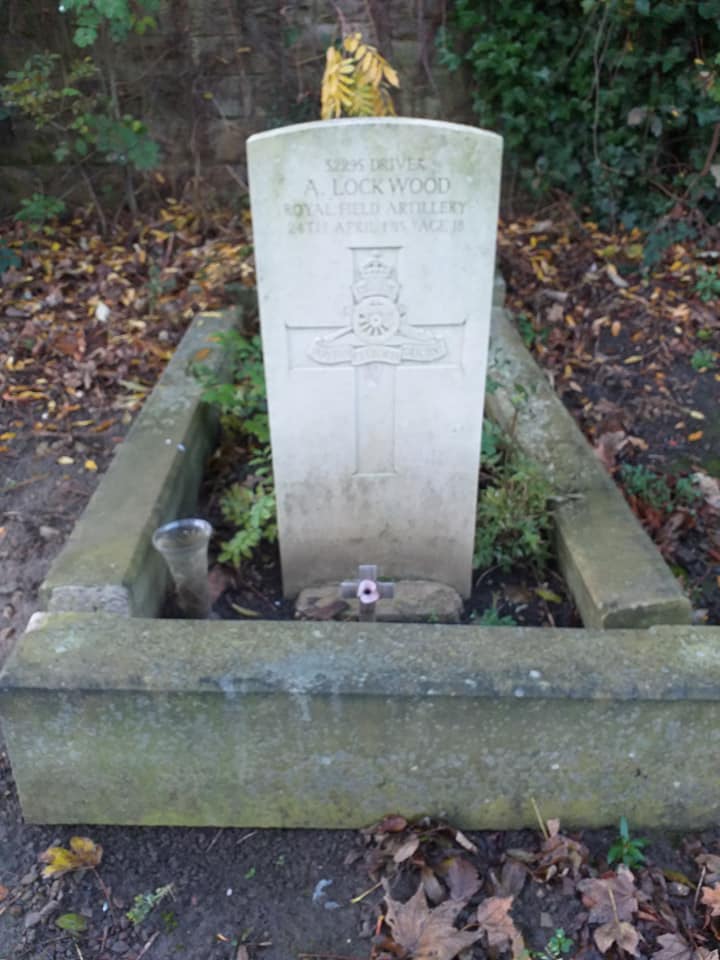
Andrew Lockwood was born in Ossett in early 1897, the youngest child and only son of Ossett builder and contractor John William Lockwood and his wife, Ann (nee Driver), who married at South Ossett Christ Church on the 30th July 1892. The couple had three children from their marriage, in addition to Andrew, two daughters, Lily and Florrie were born 1893 and 1891 respectively. All the Lockwood family were born in Ossett.
In 1901, John William Lockwood, a mason, was living with his wife and family at Intake Lane, Ossett. Sadly Ann Lockwood died in December 1906 at the age of only 45 years. In 1911, widower John William, was living with his three children at their home, 53, Intake Lane, Ossett where 15 year old Andrew Lockwood was now working in a woollen mill.
Andrew Lockwood’s army service record has not survived, but it is known that he enlisted at Ossett, and joined the Royal Horse Artillery and Royal Field Artillery as a driver. Andrew Lockwood died in unknown circumstances on the 24th April 1915, at the age of 18 years, at the Newcastle 1st Northern Hospital.
“In May 1914 the The 1st Battery, RFA were sent to Practice Camp at Trawsfynydd in North Wales where, once finished, it stayed on as part of the Depot Brigade. On 3rd August 1914, with the outbreak of War imminent, orders were received for the Battery to return to Leeds. On the 5th August 1914, further orders were received to mobilize and the following day the Battery sent 4 officers, 82 other ranks and 56 horses to various units of the British Expeditionary Force (BEF) to make other units up to their war establishment.
On the 10th August 1914, under the command of Maj. Head, the Battery itself was made up to war strength, which was achieved by the 13th with reservists and the local purchase of horses. The Battery moved to Hursley Camp near Winchester in September where it joined the Divisional Artillery of the newly formed 8th Division commanded by Maj. Gen. F J Davies. The Battery embarked on SS Armenian at Southampton and disembarked at Le Havre. From there they moved by train to Merville from where they marched to Estaires, arriving there on the 11th November 1914.
The Battery first saw action on the 16th November 1914 when they engaged enemy machine guns at Aubers in support of the infantry. On the 1st December, men from the Battery formed a guard for King George V’s inspection of the Army in the Field of War, the first Monarch to do so since King George II at Dettingen in 1743.
After three months of little action, the long-planned and much argued-over Allied Offensive in the Artois region eventually led to the Battle of Neuve Chapelle to regain ground lost in 1914 which had created a salient in the front line; the Battle lasted from 10th to 13th March 1915. 1st Battery, RFA was part of a 342-gun initial bombardment along a 2000-yard line. On the morning of 11th March at Rouge Croix, one mile north west of Neuve Chapelle, 2/Lt. de Stacpoole became the first officer of the Battery to be killed in action during the Great War.
The initial bombardment had concentrated on wire cutting but most of the German positions remained intact. Although good initial gains were made, plans to push further towards Lille had to be stopped due to strengthening German defences and the need to preserve artillery ammunition. Although we had gained a much-strengthened line it was deemed that in future offensives, destruction of the enemy positions would take priority over achieving surprise.
With nearly six months of little action, some of the routine of peace continued, with the Battery winning first prize for the Light Draught Team at the 8th Division Horse Show.
The next main offensive was the Battle of Loos in September 1915. 1st Battery’s guns were emplaced in front line trenches in support of 25th Brigade.” 1
Andrew Lockwood may have been just old enough to have served overseas and to have taken part in the Battle of Neuve Chappelle between the 13th and 15th March where it is possible that he have been wounded and then returned to the UK for treatment at the hospital in Newcastle. It is not known if he qualified for the British or the Victory medals.

Commonwealth War Graves Commission Headstone (Photograph courtesy of local historian, Joan Smith)